
current / archive / issues / faq / RSS feed / twitter /
Blog Archive: October 2021
What We Have Learned: The 'And' In 'Stan And Jack'For the past six and a half years - ever since I signed up to do a PhD and then deferred it for a year - I've been reading people's ideas about what made Marvel comics work so well in the 1960s, and for almost as much time I've been getting annoyed with the sort of analysis that insists one person alone must always be responsible for creative work.
I'd encountered this before when reading abuot The Beatles (which I've been doing for a lot longer!) where you'd constantly come across daft ideas that either John Lennon or Paul McCartney was the one and only true genius of the band. When I first started reading such books it was usually John Lennon who was the genius, but these days you're as likely to see Macca called the guiding force, with George and Ringo generally left on the sidelines. The truth of the matter, as anybody who's ever genuinely collaborated on anything will know, is that it was all of them, all four, together, who made The Beatles work, even when the songs were written or performed alone. When a group of people work together creatively somehting different and strange happens quite apart from what each individual can do on their own, to create something entirely new that wouldn't have happened any other way.
This was especially true of the first decade of Marvel comics, when Stan Lee worked with Jack Kirby or Steve Ditko (and the various inkers, letterers, colourists and editorial staff) to create the amazing characters and stories that we're still reading today. There's a very strong inclination at the moment towards dismissing Stan Lee's contribution almost entirely - I recently read a (sligtly deranged) book which claimed to have extracted the "original" stories that Jack Kirby created, before it was messed around with and ruined by Stan Lee. It's actually a collection of pub rants written down, where the author has wild guesses about ways in which the panels could be completely rearranged into a different story, but the oddest part is that throughout the entire book he only mentions Stan Lee by name once, insisting on calling him "the editor" afterwards!
It's an extreme example of an opinion that has become prevalent, that Kirby (or Ditko for is characters) did all of the real creative work, then Stab Lee came along afterwards and "just" added the dialogue. Quite apart from anything else, the idea that this was a minor contribution seems absolutely potty to me. You only have to read Kirby or Ditko's later work without Lee to see what an enormous part of early Marvel Lee's dialogue was - and not just the dialogue either, but the sassy, sarcastic, often hilarious way he wrote footnotes, or conducted letter columns, or wrote his editorials. All of that stuff was, and is, an intrinsic part of what made Marvel comics so exciting and different. Without them they would still have looked amazing, but wouldn't have been anywhere near as much fun.
Rather than accept this, however, there still seems to be a need to pin it all down to one person, and the cause of this is the same cause of all that is bad and wrong in the world of the arts and indeed the world of the world: Class! Comics are an inherently working class art from, created by and for working class people, and so are looked down upon by the traditional art world. There's an assumption that anything created as part of someone's job can't be considered as art, because of course art can only truly be created by people unconcerned with such matters i.e. those who are rich enough not to have to worry about where the rent's coming from. Similarly, art created by a group working together is considered inferior to that created by by a single individual, because again it's the privileged individual who has always been prized by the posh nits in charge.
All of which is rather a long-winded way of saying that I think people try to prise apart Stan and Jack, or Stan and Steve, or John and Paul, as a way of hammering popular working class art forms into a shape that would make them acceptable to the gatekeepers of Proper Art. This seems to me to be an utterly stupid thing to do. All comics work is the work of a group of creators, even when one person writes, draws, letters and colours their work there are still editors, printers, distributors and so on involved, but usually there are many more, all pouring their own ideas into the mix. Throughout the corpus of comics I've looked out there are examples of teams of creators doing work that they could not have done before. A great example of this is the way that pencillers and inkers work together, creating very different looks than either of them do with other people, or the way that you can see writers writing different kinds of plots to suit the artists they work with.
What I've learned then, throughout all of this, is that comics (and especially superhero comics) are a collaborative medium, and we should celebrate them because of that, rather than trying to deny it!
Rant over! Next time - a summing up of the whole lot!
posted 30/10/2021 by MJ Hibbett
(click here for permanent link)
(2) comments
What We Have Learnt: John Byrne and Secret Wars
Over the course of the past four years (four years!) of running this blog a few things have cropped up again and again that I'd like to spend the next few weeks talking about, and the first one I want to discuss is almost definitely the most important. It is this: I was right all along.
I supposed I should probably go into a bit more depth about precisely how I was right! Over my many years as a comics fan I'd already read quite a lot of the comics in this corpus, so when I started going through them all again for this project I was expecting quite a lot of disappointment, as fondly remembered stories which I'd enjoyed at the time turned out to be awful. I was also hoping for some surprises, as others that I'd felt were terrible actually turned out to be great.
There definitely were some surprises, but these all came from weird little stories I'd never read before that turned out to be great, like Marvel Superheroes #20, , Fantastic Four #200, the Spider-man cartoon series, Emperor Doom and all sorts of others. However, contrary to all my expectations, the comics I remembered as being amazing WERE amazing, and the ones I remembered as awful were often even worse that I recalled.
The two great examples of this are John Byrne's run on "Fantastic Four", and the series "Secret Wars". A couple of weeks ago I gave a presentation about John Byrne's use of previous events to enforce his "ownership" of Doctor Doom (you can read it yourself on UAL's outputs repository), and was amazed by just how much there was to say about it. Byrne does incredible storytelling work in every issue of that run, trying out new techniques, generating new twists on traditional storylines, generating new ideas and, of course, making everything look gorgeous. Yes, some of the dialogue is very hokey indeed but it always makes sense, is always exciting to read and, as I say, looks fabulous. Reading it all again as part of this I was if anything MORE impressed than I had been at the time, and can't help wondering why Byrne's work isn't more appreciated nowadays. In many ways I would have thought he's a prime candidate for being appreciated in academic fields where creators who write and draw (and in Byrne's case sometimes ink and letter) their own material are held in much higher esteem than "mere" writers and artists. Maybe it's his subject matter, which has doggedly stuck to superheroes, or maybe it's his own online remarks over the years, but I genuinely think his work is ripe for re-evaluation. Especially if it's me doing it!
On the other hand, "Secret Wars" is, to use a technical term, unforgivably shite. When it came out I thought it was awful, but decades later I wondered if maybe this was partly due to the fact that I was a teenager at the time. After all, the series regularly appears in lists of Marvel's greatest ever stories, is still referred back to - notably in Jonathan Hickman's reimagining a few years ago - and is constantly thought to be the basis of a movie in the future, so surely there must be something good about it?
No, there really isnt. There are plenty of terrible comics in this corpus, often the result of people having to finish them at speed to meet a deadline, or of creators trying to ape a new style without really understanding it, but rarely is there anything as nonsensical, ill-thought out, and unpleasantly cack-handed as Secret Wars. It was a real struggle to get through, and as close as I ever came to giving up!
Other comics were similarly as expected - George Perez is wonderful wherever he shows up, Chris Claremont is Not For Me, the second half of Lee and Kirby's Fantastic Four run is just as incredible as everybody says it is, and comics overall really did start to get rubbish the closer they got to the 1990s. As I say, this last point was something I was ready to be proved wrong on but, from reading the last few years of this corpus and then reading some later titles to, it turns out that I was right when I decided to give comics up for the whole of the 1990s!
I don't want to dwell on the negatives too much here though, so next time we'll have a think about that Lee and Kirby run mentioned earlier, as well as the idea of collaboration in general. I'm pretty sure I'll be shoehorning The Beatles into it as well!
posted 29/10/2021 by MJ Hibbett
(click here for permanent link)
(1) comments
Bits And Bobs Round-Up
Today we're taking a whirlwind trip around some of the additional items I've found featuring Doctor Doom that don't really fit into the corpus of narrative texts, but are worth a quick mention.
First of all we've got the Golden Everything Workbook which claims to be a series of "fun" puzzles for kids but is actually extra homework with images of superheroes added to make it more palatable. I don't know much about it because it's another of those texts that aren't available online and are far too expensive for me to just buy. I do know that Doctor Doom's in at least on of them though, as I found the below picture online:
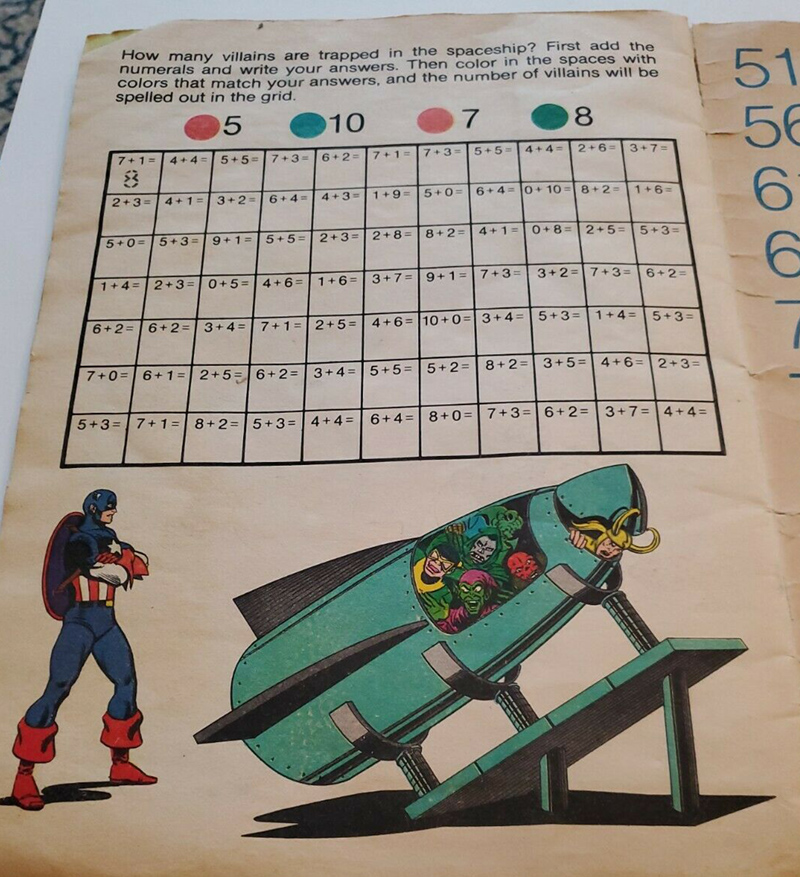 Here we see Doctor Doom in a crowd of villains - right in the centre, in fact - doing his usual job of symbolising villainy in general, something we've seen him do an awful lot over the years. Doom also appeared in the Spider-Man and the Marvel Heroes Rub 'n Play Magic Transfer Colorforms Set in 1978 and the same company's Marvel Super-Heroes Shrinky Dinks Collectors Set in 1984 as one of the few villains. We've looked at a few other examples of Doom on non-narrative promotional items over the years, such as the Marvel Slurpee cups, where Doom gets chosen as a representative of villainy, much as he does in this poster for a "super card collection" promotion, which was run in conjunction with Marvel UK in 1979.
Here we see Doctor Doom in a crowd of villains - right in the centre, in fact - doing his usual job of symbolising villainy in general, something we've seen him do an awful lot over the years. Doom also appeared in the Spider-Man and the Marvel Heroes Rub 'n Play Magic Transfer Colorforms Set in 1978 and the same company's Marvel Super-Heroes Shrinky Dinks Collectors Set in 1984 as one of the few villains. We've looked at a few other examples of Doom on non-narrative promotional items over the years, such as the Marvel Slurpee cups, where Doom gets chosen as a representative of villainy, much as he does in this poster for a "super card collection" promotion, which was run in conjunction with Marvel UK in 1979.
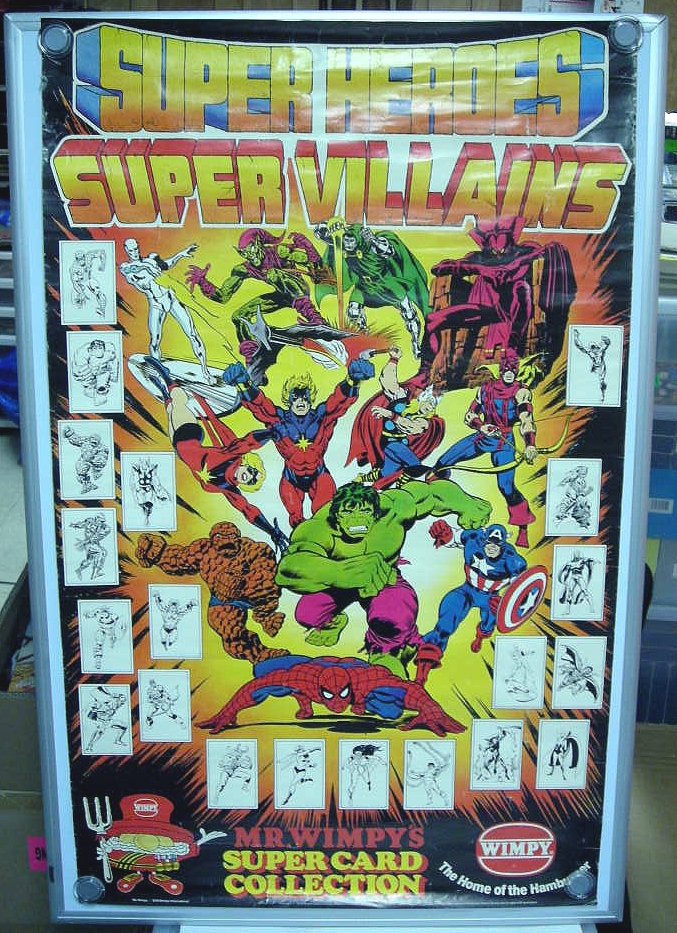 These cards don't feature in the main corpus for several reasons, including the facts that it's not issued by Marvel, and also that I don't want to pay over 200 quid on eBay to look at them! However, the main reason for not including a lot of these items is that they don't contain narratives. When I initially set this out as a condition for corpus inclusion my PhD supervisors pointed out that toys and games do have narratives, it's just that these are made up by the toys' owners as part of play. One fun-sounding but frighteningly expensive example of this is The New Fantastic Four Board Game, which was a tie-in for the New Fantastic Four cartoon featuring HERBIE the robot. Herbie's all over the game, but there's quite a lot of Doctor Doom too!
These cards don't feature in the main corpus for several reasons, including the facts that it's not issued by Marvel, and also that I don't want to pay over 200 quid on eBay to look at them! However, the main reason for not including a lot of these items is that they don't contain narratives. When I initially set this out as a condition for corpus inclusion my PhD supervisors pointed out that toys and games do have narratives, it's just that these are made up by the toys' owners as part of play. One fun-sounding but frighteningly expensive example of this is The New Fantastic Four Board Game, which was a tie-in for the New Fantastic Four cartoon featuring HERBIE the robot. Herbie's all over the game, but there's quite a lot of Doctor Doom too!
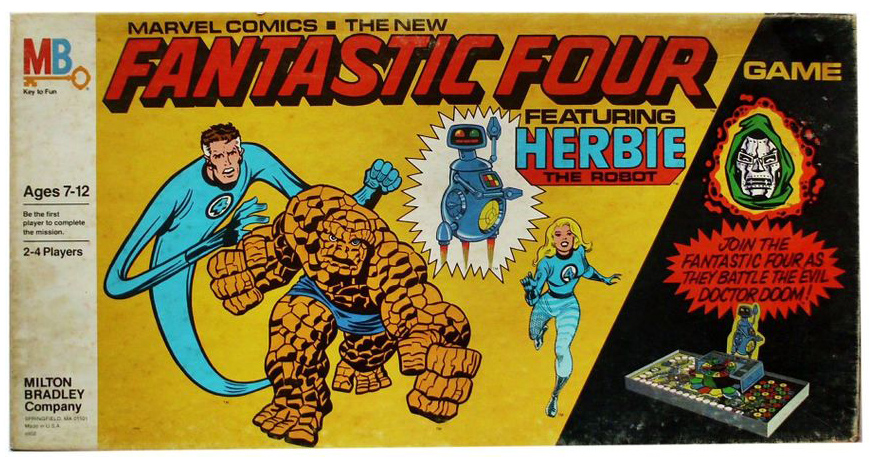 The classic example of toys featuring Doom is probably the Secret Wars Action Figures. I ruled this out of the corpus early on, so never covered them on this blog, which is probably a good idea as this is one item I would have been sorely tempted to hunt eBay for, especially after watching this Doom-heavy TV advertisement:
The classic example of toys featuring Doom is probably the Secret Wars Action Figures. I ruled this out of the corpus early on, so never covered them on this blog, which is probably a good idea as this is one item I would have been sorely tempted to hunt eBay for, especially after watching this Doom-heavy TV advertisement:
I love the way that "Doctor Doom and the Doom Platoon" is intoned with such gravitas. They should bring that back as a team name! Doom also featured (sort of) in an advert for Personna Double Razors starring Stan Lee. Well, he was mentioned anyway - apparently Stan says he has to be able to have a worry-free shave because "I've got Spider-man and all these characters and super villains like Dr. Doom to worry about", although the actual video has been lost to time. The best I could find was this breakdown of it on twitter:
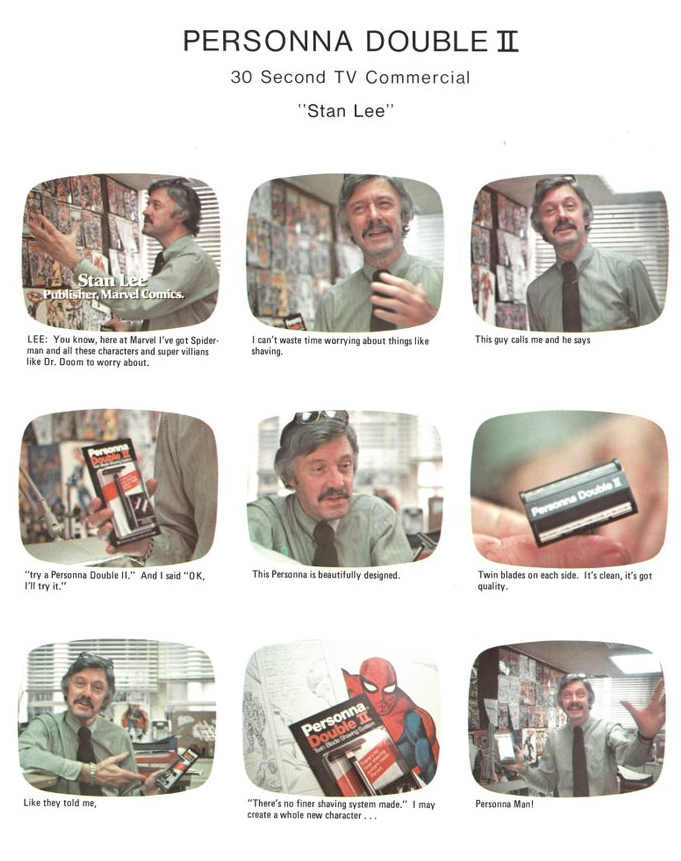 And finally, the item that I would most like to have included in the corpus but couldn't really justify, is the Marvelmania Doctor Doom poster specially created by Jack Kirby.
And finally, the item that I would most like to have included in the corpus but couldn't really justify, is the Marvelmania Doctor Doom poster specially created by Jack Kirby.
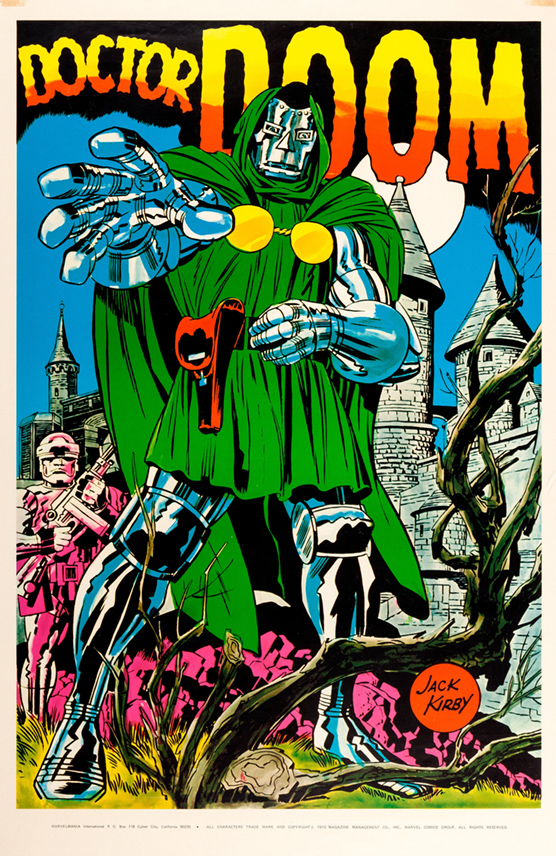 I mean, just look how gorgeous that is! I love this image so much I have used it in Conference Papers as a way to explain how Doom's signifiers work - this is an especially great example because it not only includes aspects of Doom's appearance but also his name, actions, location and on top of everything else Jack Kirby's name as a textual and marketing author. It also looks amazing, but sadly it's not a narrative and it wasn't issued by Marvel, so I couldn't really justify it. It's also very expensive - this poster was sold on an auction site for over $400 - otherwise I would definitely have been chasing it on eBay!
I mean, just look how gorgeous that is! I love this image so much I have used it in Conference Papers as a way to explain how Doom's signifiers work - this is an especially great example because it not only includes aspects of Doom's appearance but also his name, actions, location and on top of everything else Jack Kirby's name as a textual and marketing author. It also looks amazing, but sadly it's not a narrative and it wasn't issued by Marvel, so I couldn't really justify it. It's also very expensive - this poster was sold on an auction site for over $400 - otherwise I would definitely have been chasing it on eBay!
And that just about rounds up all the extra items I've found over the years, which in turn almost rounds off this whole blog. All that remains is to have a look back at some of the Lessons Learned, which begins in a couple of weeks (after I've been on holiday!) with the startling revelation that Teenage Me was - incredibly - correct in almost all his comics opinions back in the 1980s. Join me next week to find out why!
posted 15/10/2021 by MJ Hibbett
(click here for permanent link)
(0) comments
Lest We Should Goof...!
In 1983 Marvel comics were targetted by corporate raider Mario Gabelli, who attempted a hostile takeover of the company. Marvel needed money, quickly, to fight him off, and so then-President Jim Galton ordered Jim Shooter to churn out a series of reprints one-shots that could raise cash without involving much expenditure. Today we're looking at one of those one-shots, 'The Official Marvel No-Prize Book'.
As anyone who follows this sort of thing knows, a 'No-Prize' is awarded not just for spotting a mistake, but also for offering an in-continuity explanation that means it's not an error at all. This book, however, does no such thing, instead giving a list of mistakes through the ages like a 'blooper reel'. Actually, when I say it offers mistakes through the ages, it actually concentrates almost entirely on those made in the very early days of Marvel. I can see that there would have been more errors back then, with a small team of creators bashing out the whole line under Stan Lee's less than exacting editorial eye (a lot of the mistakes are by him!), but still I would have thought there'd be a few more modern examples. Maybe Jim Shooter didn't like to admit to them?
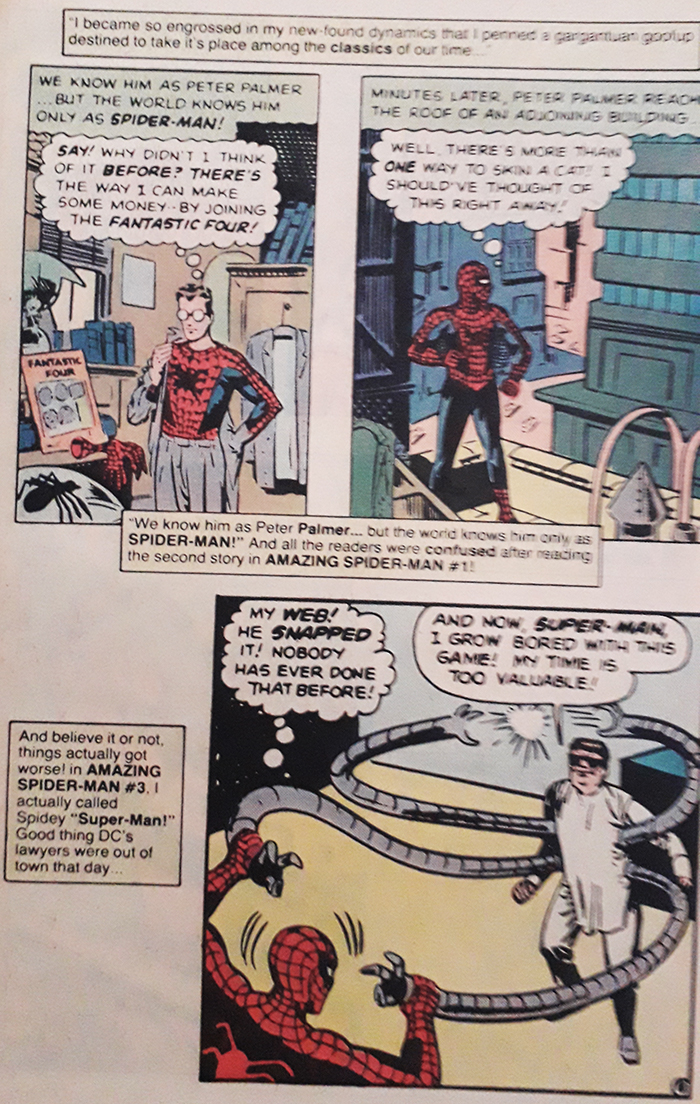 The comic makes no bones about the fact that it's a money-making exercise. The credits on the inside cover begin with "These people, who all love their jobs, were totally against this dumb idea*" with the note adding below "*But Jim Shooter backed a truck up to the office filled with so much money... well... what would you do?"
The comic makes no bones about the fact that it's a money-making exercise. The credits on the inside cover begin with "These people, who all love their jobs, were totally against this dumb idea*" with the note adding below "*But Jim Shooter backed a truck up to the office filled with so much money... well... what would you do?"
The comic is narrated by a caricature of Stan Lee who seems to be wearing a very badly fitted toupee.
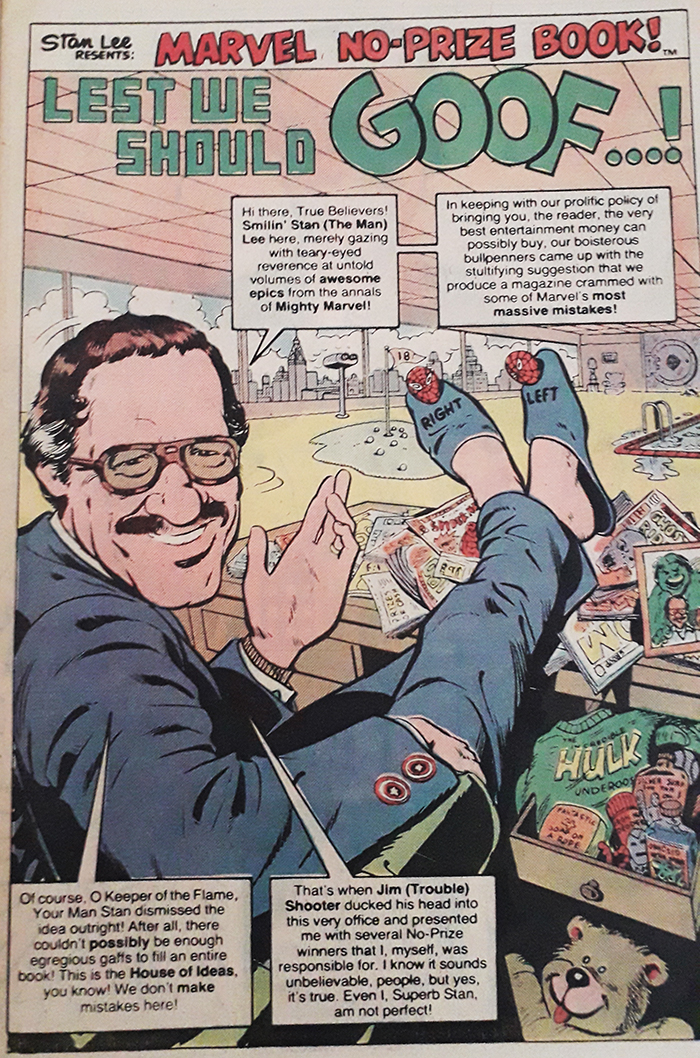 Maybe that's the cause of the rather strongly worded editorial where Lee states (semi-humorously) "I had nothing to do with this fiasco! That's not me talking
Maybe that's the cause of the rather strongly worded editorial where Lee states (semi-humorously) "I had nothing to do with this fiasco! That's not me talking Doctor Doom does not appear inside the comic itself, but is (sort of) the cover star, as we see him pulling off his mask to reveal the face of Stan Lee. Apparently Jack Kirby once drew a similar caricature of Lee as Doom shortly after he left for DC comics, but I can't find any evidence of it online. There are, however, plenty of images of Funky Flashman's, Kirby's even less well-toupeed version of Lee from The New Gods!
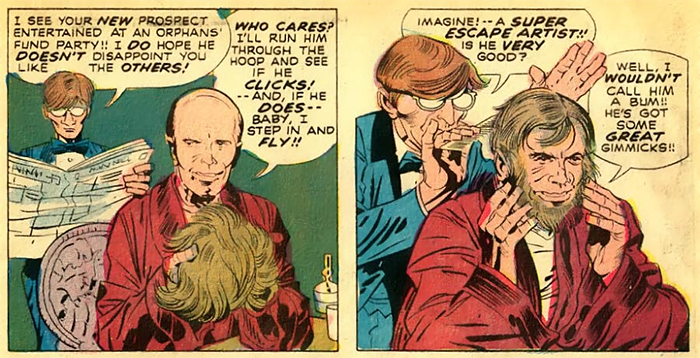 That's just about your lot for narrative appearances by Doctor Doom, however slimly connected they might be, but come back next time for a great big round up of all the other bits and bobs I've found over the past few years!
That's just about your lot for narrative appearances by Doctor Doom, however slimly connected they might be, but come back next time for a great big round up of all the other bits and bobs I've found over the past few years!
posted 8/10/2021 by MJ Hibbett
(click here for permanent link)
(0) comments
Doomsday
Today we're looking at the most heinous omission from my PhD corpus - the novel "Doomsday" by Marv Wolfman!
This was released as part of a series of Marvel Novels by Pocket Books, a subsidiary of Simon & Schuster, in 1979. It claims to be about The Fantastic Four, but oh boy is it ever about Doctor Doom! He is very much the main character throughout, carries most of the plot, and is surprisingly coherent with his comics equivalent, unlike the FF who have some major changes made to their origins.
I missed this one altogether when I was putting together my original corpus, and only discovered it this year because of a story in Bleeding Cool about it being reissued later this year as an audiobook. In my defence, none of the sites I looked at mentioned it, and it isn't in the Grand Comics Database because it isn't a comic, but it would have been amazing to have been able to include it in my PhD analysis as it's got so much to say about Doctor Doom.
The story features Doctor Doom turning up at his college reunion, in a vaguely similar way to what happened back in Fantastic Four #143 by Gerry Conway. However, where that was a cunning ruse to lure Mr Fantastic into his grasp, this time it's ... well, it's a cunning ruse to lure Mr Fantastic into his grasp, except here Doom turns up at the reunion unnanounced, rather than organising it, and invites all of the attendees to come back with him to Latveria for a week. Weirdly, they all agree - I guess in America people take a packed suitcase to college reunions, just in case?
Doom takes everyone on a tour of Latveria, as he is wont to do (for example in the Spider-man cartoon), and everyone is duly impressed, except for the FF who, of course, get stuck in some deathtraps. While they're safely kept out of his way Doom zooms back to the Baxter Building where he gains access to the Negative Zone, harnesses its power, then goes to Stonehenge where he manages to pierce the veil into the after-life, so he can try and rescue his mother.
All of the above takes most of the book, and it goes at a right old clip. It's very easy reading, but you do get the feeling that Marv Wolfman wrote it at a similarly fast pace, as there's lots of repetition of words and quite a lot that doesn't make sense. He also has a tendency to say things are "indescribable" before going on to describe them in the same sentence.
Doom is very Doom throughout the story, but the Fantastic Four do get tweaked a bit, notably the first meeting between Reed Richards and Sue Storm, which now takes place at a party which Sue is attending as a Famous Model And Actress, rather than the original rather creepy version where she's a young girl and Reed is the college-age lodger in her family home. It's a nice way of re-doing it, although the fact that she's an actress doesn't really get used anywhere.
There also seems to be a big assumption that the reader already knows who the Fantastic Four are. We get a re-tellinbg of Doom's origin threaded through the book, but very little about the FF and how they work. Ben Grimm, for instance, just turns up as an orange monster without any explanation or much description. I guess there was a feeling that people who didn't know Marvel comics wouldn't be bothering with these novels, although that doesn't explain why there's so much of Doctor Doom's background in there. My guess is that it's a similar idea to Noah Hawley's "Doctor Doom" movie proposal - his origin story is, like Spider-man's, the sort of story that works as a screenplay, with a character learning and changing across three acts, whereas the Fantastic Four's origin is basically "some people go into space and have an accident", which isn't quite as engaging.
There's some politics in here too, similar to the ideas Wolfman explored in Fantastic Four 198-200 around the same time. Johnny Storm meets (and inevitably falls in love with) the beautiful leader of the Latverian resistance, who asks why they don't overthrow Doom and free her people, Reed Richards says they can't possibly do that, the people must rise up themselves. By the end of the book the people have done just that, "inspired" by the FF, but even then the Latverians are shown as weak and probably unworthy of rebellion, with many of them wondering how they'll be able to get enough to eat without Doom.
I say that the people rise up, as that's how it's put across in the narration, but that's not really what happens. Once Doom gets into The After Life he meets his father and mother, both of whom renounce him for being evil, and he's dragged off, presumably into hell, removing him from power. The people of Latveria don't really do anything, and the only inspiration provided by the FF is that they manage to escape from the Death Traps. As I say, this is very much the story of Doom, who pretty much gets everything he wants and only fails at the final hurdle due to Being Evil.
The whole thing ends with Boris, who has been in it quite a lot, sitting in Doom's throne room. Somehow he's not been arrested as Doom's right hand man, and is just setting off to live the rest of his life when he hears the sound of Doom calling to him from wherever he is now... THE END! It's a lovely, if not entirely unexpected, B-movie ending for a very B-movie storyline which featured a whole lot of Doom. I would thoroughly recommend reading it for anyone who can find it, or indeed listening to it when the audiobook comes out. I know I'll be buying it!
posted 1/10/2021 by MJ Hibbett
(click here for permanent link)
(0) comments